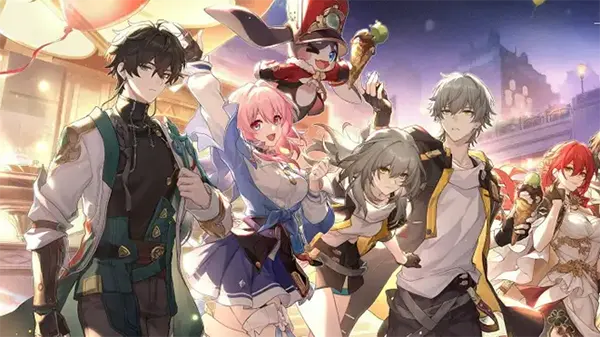Honkai: Star Rail — A Deep Space RPG by HoYoverse
Honkai: Star Rail is a turn-based science fiction RPG developed by HoYoverse, the creators behind the globally successful Genshin Impact. Since its global launch, the game has established itself as a cornerstone of mobile and PC role-playing games, thanks to its compelling narrative, rich universe, and dynamic character system. As of February 2025, it continues to evolve with regular content updates and a growing international player base. Let’s explore what makes Honkai: Star Rail such a notable entry in modern RPG gaming.
A Vast Universe and Rich Lore
Set aboard the Astral Express, players travel between planets, each with its unique culture, political struggles, and mythologies. The game offers a deeply interconnected story, influenced by philosophical themes and layered worldbuilding that grows with every update. Locations such as Jarilo-VI, Xianzhou Luofu, and Herta Space Station each serve as immersive hubs of storytelling and exploration.
The writing quality maintains high standards, blending dialogue with cinematic cutscenes and immersive lore entries. Players are encouraged to uncover backstories not only through missions but also through environmental clues and collectible data logs. This results in a sense of continuity and depth uncommon in many other free-to-play titles.
What sets Star Rail apart is how it uses sci-fi not as a gimmick but as a genuine narrative backbone. The Stellaron threat, Aeons mythology, and ethical dilemmas around artificial life add substantial weight to its quests and character arcs.
Main Characters and Factions
The playable characters in Honkai: Star Rail are known as Trailblazers, recruited from diverse backgrounds and galaxies. Each comes with a personal motivation, unique skills, and individual quests that feed into the grander story. Characters like Kafka, Welt, and Jing Yuan are pivotal not just for gameplay, but for narrative cohesion.
Factions such as the Interastral Peace Corporation or the Antimatter Legion provide dynamic tension across regions. These factions clash ideologically and militarily, adding layers to the game’s political narrative and giving each planet its own identity. The storytelling frequently explores moral ambiguity rather than clear-cut heroes and villains.
Voice acting in multiple languages, including British English, further enriches the immersion, especially for characters with complex emotional arcs. This makes the game more accessible to global audiences while retaining narrative depth.
Turn-Based Combat Mechanics and Strategy
Honkai: Star Rail features a turn-based combat system that prioritises tactical depth over raw speed. Each character belongs to a path (e.g., Destruction, Harmony, Nihility) and wields an elemental type like Quantum, Imaginary, or Physical. Combat revolves around strategic team-building and skill rotations rather than real-time reflexes.
Enemies have weaknesses tied to specific elements, and exploiting these through a system called Weakness Break is key to winning tougher battles. Teams must balance DPS, support, and control roles, encouraging thoughtful character development and synergy.
As of February 2025, new systems such as the “Path Resonance” and extended Relic sets have deepened combat diversity. The inclusion of simulated universes and roguelike gameplay modes adds even more tactical variation to the experience.
Relic Sets and Team Composition
Relics function as gear, boosting stats and granting bonuses when equipped in sets. Choosing the right combination of relics can greatly enhance a character’s effectiveness, especially in high-difficulty content like Memory of Chaos or Pure Fiction mode.
Team synergy is vital. Players often pair buffers like Bronya with high-damage characters such as Dan Heng • Imbibitor Lunae, creating optimal rotations. The inclusion of debuffers like Silver Wolf enables more flexible strategies for elite fights.
Meta strategies evolve constantly with each patch. Dedicated players track performance changes through tier lists and damage simulators, keeping the community engaged in ongoing optimisation.

Progression, Events, and Endgame Systems
The game’s progression model is anchored by story chapters, light cone upgrades, and character ascension. Levelling is supported by dailies, weekly missions, and energy systems, which balance grind with reward pacing. Players are incentivised to log in consistently without excessive pressure.
Regular events add variety. As of early 2025, events like “Apocalyptic Shadows” and “Golden Hour Crisis” have included both combat trials and puzzle content. These events often come with limited-time rewards, including exclusive light cones and character skins.
Endgame content includes high-difficulty combat in Simulated Universe: Swarm Disaster, Abyss-style Memory of Chaos, and rotating challenges. These offer materials for relics, credits, and character growth, ensuring veteran players remain engaged long-term.
Monetisation and Community Engagement
Honkai: Star Rail uses a gacha system for character and light cone acquisition. However, the game maintains a balance by allowing free-to-play users to build strong teams through generous login rewards, limited banners, and event currency.
Transparency around drop rates and frequent updates has improved trust within the community. Moreover, the developers actively engage with players via dev notes, livestreams, and feedback surveys, showing a clear effort to sustain goodwill.
The player community is thriving on platforms like Reddit and Discord, offering theorycrafting, fan art, and guides. HoYoverse has also hosted global events and merchandise collaborations, further expanding the game’s cultural footprint.